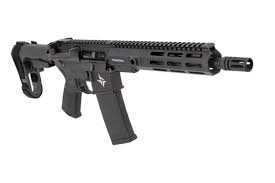
Categories:
The AR-15 rifle, originally designed for military use, has gained significant popularity among hunters in recent years. Its lightweight design, versatility, and customizable features have made it a preferred choice for various hunting applications. Whether you are a seasoned hunter or new to the sport, understanding the suitable calibers and tips for success when hunting with an AR-15 is crucial. When it comes to selecting the appropriate caliber for your AR-15 rifle, several factors should be considered.
The .223 Remington/5.56x45mm NATO caliber is the most common choice due to its availability and affordability. It offers sufficient power for varmint hunting and small-to-medium game at moderate ranges. However, if you are targeting larger game such as deer or hogs, you may want to consider alternative calibers such as 6.5 Grendel or .300 AAC Blackout that provide more stopping power.
To ensure success while hunting with an AR-15 rifle, certain tips can greatly enhance your experience. Firstly, familiarize yourself thoroughly with your rifle’s operation and practice proper gun safety protocols at all times. Additionally, invest in quality optics that suit your specific hunting needs and terrain conditions. Furthermore, mastering shot placement is essential when using an AR-15 rifle for hunting purposes.
When it comes to hunting with an AR-15, selecting the appropriate caliber is crucial for achieving success and ensuring an ethical hunt. The choice of caliber directly impacts factors such as shot placement, knockdown power, and effectiveness on different game species. Therefore, it is essential for hunters to understand the importance of choosing suitable calibers before heading out into the field.
First and foremost, shot placement is paramount when hunting. Different calibers have varying levels of accuracy and effective range, which can greatly affect a hunter’s ability to place shots precisely. Opting for a suitable caliber ensures that you have enough power and accuracy to hit your target reliably. Additionally, knockdown power is vital in hunting situations. A suitable caliber should possess enough energy to deliver a lethal shot without causing unnecessary suffering or risking wounded game escaping into dense vegetation.
The right combination of bullet weight and velocity is necessary to achieve humane kills across various distances. Moreover, different game species have specific requirements in terms of caliber selection. Large-bodied animals require heavier calibers that can penetrate deep into their vital organs, while smaller game may call for lighter calibers that provide sufficient stopping power without excessive damage. Ultimately, understanding the significance of choosing suitable calibers equips hunters with knowledge needed to make informed decisions in the field.
The AR-15 platform is renowned for its versatility, allowing shooters to adapt the rifle to various hunting scenarios. One of the key considerations when choosing an AR-15 for hunting is selecting the appropriate caliber. While .223 Remington/5.56 NATO is the standard caliber for AR-15 rifles, several other popular calibers are gaining traction in hunting circles. One such caliber is the 6.5 Grendel, which offers excellent long-range capabilities and impressive accuracy.
Its flat trajectory and minimal recoil make it ideal for hunters targeting game at extended distances. Another popular choice is the .300 Blackout, known for its ability to deliver heavy-hitting rounds with superior terminal performance. This caliber excels in close-quarters hunting scenarios and suppressor use. For those seeking a more powerful option, the .450 Bushmaster and .458 SOCOM calibers are well-regarded choices.
These larger calibers provide substantial stopping power and are suitable for taking down big game animals like hogs or deer. When selecting a caliber for your AR-15 rifle, it’s crucial to consider factors such as intended game species, shooting distance, and local regulations governing bullet types or energy requirements for hunting. Additionally, always ensure you choose ammunition from reliable manufacturers that offer controlled expansion bullets designed specifically for ethical hunting purposes.
Selecting the right caliber for hunting with an AR-15 is crucial to ensure optimal performance and ethical hunting practices. Several factors should be carefully considered before making a decision:
1. Game Size and Type: The caliber chosen should match the intended game species and their average size. Smaller game, such as varmints or predators, may require lighter calibers like .223 Remington or 6.5 Grendel, while larger game like deer or hogs may necessitate heavier calibers such as .308 Winchester or 6.8 SPC. 2. Distance: Understanding the typical shooting distances in your hunting area is essential in selecting an appropriate caliber.
For longer-range shots, consider calibers that offer flatter trajectories and higher energy retention, like the .243 Winchester or 6mm Creedmoor. 3. Regulations: Familiarize yourself with local hunting regulations to ensure compliance when choosing a caliber. Some regions have specific restrictions on calibers allowed for certain game species. 4. Recoil Management: Recoil can significantly impact accuracy and shooter comfort, particularly during follow-up shots.
Choosing a caliber that matches your shooting capabilities and comfort level is crucial for consistent shot placement. 5.
1. Choose the Right Caliber: One of the most important factors to consider when hunting with an AR-15 is selecting the appropriate caliber for your intended game. Popular choices include .223 Remington/5.56 NATO, .300 Blackout, and 6.8 SPC. Research the specific characteristics of each caliber and match it to your target species and hunting conditions. 2. Optimize Your Ammunition: Once you’ve determined the suitable caliber, invest in high-quality ammunition designed for hunting purposes.
Select bullets that offer controlled expansion and maximum energy transfer upon impact to ensure an ethical kill. 3. Practice Proper Shot Placement: As with any gun, shot placement is crucial when hunting with an AR-15 rifle. Take time to practice at various distances and positions to become proficient in placing accurate shots on vital areas of your target animal. 4. Utilize Appropriate Optics: Equipping your AR-15 with suitable optics can greatly enhance your hunting success by improving accuracy and target acquisition speed.
Consider using variable power scopes or red dot sights depending on your hunting environment. 5. Adapt to Stealthy Approaches: The AR-15’s lightweight design makes it ideal for stalking and spot-and-stalk techniques during hunts.
Proper ammunition selection is crucial when hunting with an AR-15, as it ensures humane and ethical kills while maximizing the effectiveness of your shots. When considering suitable calibers for different game sizes and distances, several factors come into play. For small game such as rabbits or squirrels, a .223 Remington or 5.56x45mm NATO caliber is recommended. These rounds offer sufficient velocity and accuracy for precise shots without excessive damage to the meat.
When hunting medium-sized game like deer or antelope, a larger caliber such as the .300 AAC Blackout or 6.5 Grendel provides adequate power and range. These cartridges offer enhanced energy transfer upon impact, ensuring a quick and clean kill. For larger game such as elk or bear, more powerful calibers like the .308 Winchester or 6.8 SPC are preferable. These rounds deliver greater stopping power at longer distances, providing the necessary penetration to take down big game effectively.
It’s important to consider the distance you’ll be shooting from as well. For shorter ranges within dense woods or thick brush, lighter bullets with controlled expansion are ideal to prevent over-penetration. Conversely, for longer shots in open fields, heavier bullets that retain energy over extended distances should be chosen to ensure sufficient knockdown power.
The role of shot placement in hunting with AR-15 rifles is a crucial aspect that cannot be underestimated. While the AR-15 platform offers various calibers suitable for hunting, the effectiveness of any caliber ultimately depends on the shooter’s ability to place accurate shots.
One key consideration when aiming to achieve ethical and humane kills is selecting an appropriate target area. Vital organs such as the heart and lungs are prime targets, ensuring a quick and efficient takedown. The AR-15’s inherent accuracy makes it capable of delivering precise shots necessary for this type of shot placement.
It is essential for hunters to familiarize themselves with the anatomy and behavior of their intended game. Understanding where vital organs are located and how they may react when hit will greatly enhance one’s chances of success. Additionally, factors such as distance, wind conditions, and shooting position should also be taken into account before taking a shot.
Proper shot placement not only ensures a clean kill but also minimizes the risk of wounded or lost animals. Ethical hunting practices dictate that hunters prioritize making clean kills to respect both wildlife and conservation efforts.
In conclusion, shot placement plays a pivotal role in hunting with AR-15 rifles. It requires skill, knowledge, and practice to consistently deliver accurate shots on vital areas. By mastering this aspect of marksmanship, hunters can ethically harvest game while showcasing responsible stewardship towards wildlife populations.
When considering using an AR-15 for hunting, it is crucial to understand both its limitations and advantages. While this popular semi-automatic rifle has gained popularity among hunters, especially in predator control and varmint hunting, it may not be suitable for all types of game. One limitation of the AR-15 platform is its caliber restrictions. The standard AR-15 chambered in .223/5.56mm is more suitable for small to medium-sized game such as coyotes or wild hogs.
For larger game like deer or elk, cartridges with larger calibers such as .300 Blackout or 6.8 SPC might be preferred. It’s important to research and select a caliber that aligns with your target species. On the other hand, one significant advantage of the AR-15 for hunting is its versatility and customization options. With an array of aftermarket parts available, hunters can adapt their rifles to suit their specific needs and preferences.
Features like adjustable stocks, optics, and muzzle devices enable improved accuracy and ease of use in various environments. Additionally, the lightweight nature of the AR-15 makes it highly maneuverable in tight spaces like dense woods or brushy areas where quick target acquisition is essential.
In conclusion, hunting with the AR-15 rifle can be a rewarding experience when approached with responsible and ethical practices. It is essential to prioritize safety, accuracy, and respect for both the game and the environment. By adhering to these principles, hunters can ensure the sustainability of their sport while minimizing any negative impacts. Firstly, it is crucial to select suitable calibers for hunting with an AR-15.
This ensures humane kills without causing unnecessary suffering to the animal. Popular options include .223 Remington or 6.5 Grendel rounds, which offer sufficient power and accuracy for most game species. Additionally, hunters must prioritize gun safety at all times. This involves being familiar with local laws and regulations regarding hunting seasons, licenses, and bag limits. Regular practice at shooting ranges helps improve marksmanship skills and ensures accurate shots that swiftly bring down game animals.
Responsible hunters also understand the importance of ethical harvesting practices. They aim for clean kills by targeting vital organs to minimize suffering. Furthermore, they respect property boundaries and obtain proper permission from landowners before hunting on private lands. Lastly, ethical hunters respect nature by minimizing their impact on wildlife habitats. They follow Leave No Trace principles by properly disposing of waste materials, avoiding unnecessary disturbance to wildlife areas, and respecting protected species or habitats.








Colt
Colt M4 Carbine
Colt LE6920
Colt AR-15 A4
Daniel Defense
DDM4 V7
DDM4 V9
DDM4 V11
DDM4 ISR (Integrally Suppressed Rifle)
Smith & Wesson (S&W)
M&P15 Sport II
M&P15 Tactical
M&P15T
Bravo Company Manufacturing (BCM)
BCM Recce-16
BCM Recce-14
BCM MCMR Series
Aero Precision
M4E1 Series
AC-15
AR15 Pistol (Various Configurations)
Ruger
Ruger AR-556
Ruger SR-556
Ruger AR-556 MPR (Multi-Purpose Rifle)
Springfield Armory
Saint Victor
Saint Edge
Saint AR-15
PSA (Palmetto State Armory)
PSA PA-15
PSA AR-V
PSA Jakl (AR Pistol)
FN America
FN 15 Tactical Carbine
FN 15 Patrol
FN 15 DMR
Wilson Combat
Recon Tactical
Super Sniper
Protector Carbine
SIG Sauer
SIG M400 Tread
SIG M400 Elite
SIG M400 SDI
LWRC International
IC DI (Direct Impingement)
IC SPR
IC A5
Bushmaster Guns
XM-15 QRC
Bushmaster MOE
XM-15 Patrolman
Rock River Arms
LAR-15 Entry Tactical
LAR-15 Predator
LAR-15 Elite Comp
Stag Arms
Stag 15 Tactical
Stag 15L (Left-Handed Models)
Stag 15 Valkyrie
Noveske Rifleworks
Noveske Gen 4 N4
Noveske Space Invader (AR Pistol)
Noveske Recon
Anderson Manufacturing
AM-15 Optic Ready
AM-15 M4 Carbine
AM-15 Precision Rifle
Adams Arms
AA-15 Piston Rifle
P2 AARS (Adams Arms Rifle Series)
Black Rain Ordnance
SPEC15 Series
BRO Predator
Fallout 15
Diamondback Guns
DB15 Series
DB15CCMLB
DB15EB
Del-Ton Inc.
DTI-15
Del-Ton Echo 316H
Sierra 316M
Windham Weaponry
Windham SRC
Windham VEX-SS
Windham RMCS-4 (Caliber Conversion System)
Christensen Arms
CA-15 G2
CA-15 Recon
CA-15 Titanium Edition
Patriot Ordnance Factory (POF-USA)
Renegade Plus
P415 Edge
Revolution DI
LaRue Tactical
PredatAR
OBR (Optimized Battle Rifle)
LaRue Stealth 2.0
Battle Arms Development
Workhorse Patrol Carbine
BAD556-LW (Lightweight)
Authority Elite Rifle
Faxon Guns
Ascent AR-15
FX-19 (AR Pistol)
Streamline Ultralight Series
KE Arms
KE-15 SLT (Super Lightweight Tactical)
KE-15 Scout Carbine
Primary Weapons Systems (PWS)
MK1 MOD 2-M
MK116 PRO
MK107 (Piston AR Pistol)
ZEV Technologies
ZEV Core Elite Rifle
ZEV AR15 Billet Rifles
Franklin Armory
BFSIII AR-C1
Militia Model
F17-L (Chambered in .17 WSM)
Seekins Precision
SP15 DMR
NX15 Skeletonized Rifle
Havak Bravo
Aero Precision (Additional Models)
EPC-9 (Pistol Caliber ARs)
VG6 AR Rifles
Barrett Guns
REC7 DI
REC7 Gen II
CMMG
MK4 RCE
Resolute 300
Banshee (AR Pistol)
DPMS Panther Arms
Panther Oracle
Panther LR-308
H&K (Heckler & Koch)
HK MR556A1
HK416 (Military Variant)
Rock Island Armory (Armscor)
VR-80 Tactical AR (Shotgun AR Platform)
Troy Industries
Troy SPC-A3
Troy PAR (Pump Action AR)
Wilson Tactical
Tactical Recon AR
Protector Series
F1 Guns
FDR-15 Skeletonized Rifle
BDRx-15 Series
Juggernaut Tactical
JT-15
JT-10 Precision Rifle
AeroSurplus
Surplus AR-15 Rifles (Budget Models)
Thunder Tactical
AR-15 Basic Carbine
Tactical Builder Sets
Radical Guns
RF-15
Forged AR-Series
Dark Storm Industries
DS-15 Featureless Rifles
DS-10 Typhoon
DRD Tactical
Paratus
Aptus AR Rifles
Bear Creek Arsenal
BCA-15
AR Complete Upper Builds
Aero Survival Rifles (ASI)
ASR Tactical Series
Tactical Edge
WARFIGHTER Series
AR-15 Lightweight Rifles
Lone Star Armory
TX15 DMR
TX15 Carbine
HERA Arms
HERA H7
HERA AR-15 Lower Builds
IWI (Israeli Weapon Industries)
Zion-15
DRD Tactical
Tactical Modular Rifles
Quick-Takedown Rifles
V Seven Weapons
1776 Rifle
Hyperlite Rifle
Core Rifle Systems
Core15 Tac III
Core15 Patrol Rifle
Armalite (Original AR-15 Creator)
M15 Tactical
M15 A4 Carbine
DEF15 (Defensive Sporting Rifle Series)
PSA (Palmetto State Armory Additional Models)
PSAK-47 Hybrid (AR-AK Style Hybrid)
PSA Dagger (Pistol Caliber Configurations)
Odin Works
OTR-15
Odin Recon Rifle
Maxim Defense
MDX-508 PDX (Compact AR Pistol)
MDX-510 Rifle